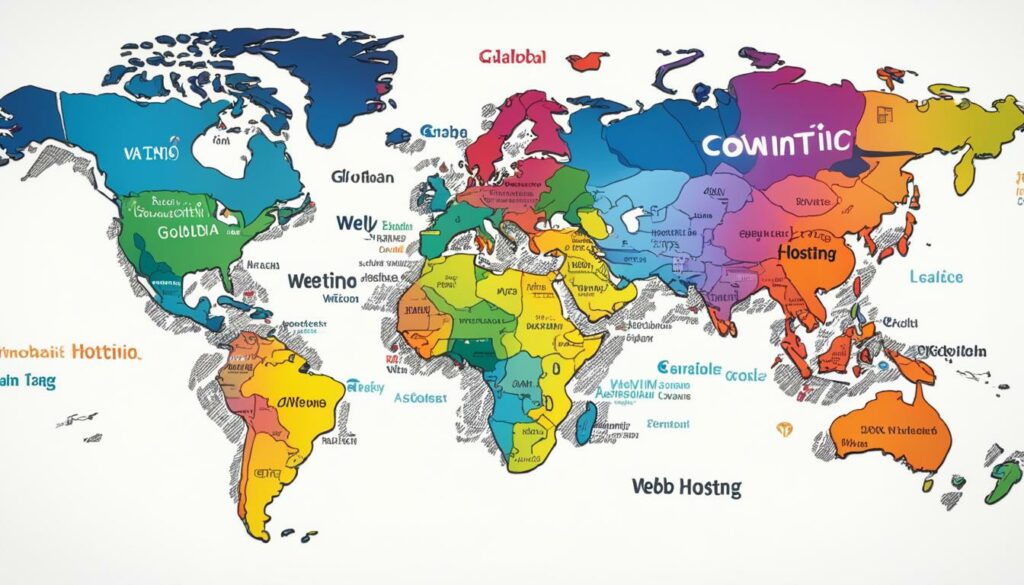WordPress is a powerful content management system (CMS) that allows you to build and manage your own website. However, hosting a WordPress site comes with its fair share of challenges. From security vulnerabilities to slow performance, managing plugins and themes to troubleshooting confusing errors, there are common issues that can hinder the smooth operation of your WordPress site.
To help you overcome these challenges and ensure optimal performance for your WordPress site, we recommend WordPress Hosting from BoostedHost. With their reliable and high-performance hosting solutions, you can focus on your content and business without worrying about the technical aspects of hosting.
Sign up now through this link: www.boostedhost.com/wordpress-hosting
Key Takeaways:
- WordPress hosting can present challenges, but they can be overcome with the right strategies and solutions.
- Security vulnerabilities can be addressed by keeping your installation up to date, choosing well-vetted plugins and themes, and implementing strong passwords and SSL/TLS encryption.
- Slow performance can be improved by optimizing your WordPress site with caching plugins, reducing plugin usage, and considering the use of a content delivery network (CDN).
- Managing plugins and themes requires careful selection of necessary ones, regular updates, and troubleshooting any conflicts that may arise.
- Confusing errors can be resolved by troubleshooting and searching for solutions online.
By addressing these challenges and staying informed about best practices, you can ensure the smooth operation of your WordPress site and provide an optimal user experience for your visitors.
Remember, with WordPress Hosting from BoostedHost, you can overcome these challenges and focus on creating an exceptional website. Sign up now!
Securing Your WordPress Site: Protecting Against Security Vulnerabilities
When it comes to hosting a WordPress site, one of the biggest challenges you may face is the potential for security vulnerabilities. Hackers often target WordPress websites due to the availability of core code files and third-party plugins and themes. To ensure the safety of your WordPress site and protect it from cyber attacks, it’s crucial to implement strong security measures.
To safeguard your WordPress installation, follow these key steps:
- Keep everything up to date: Regularly update your WordPress core, plugins, and themes to eliminate known vulnerabilities and ensure compatibility.
- Choose reliable plugins and themes: Opt for well-vetted plugins and themes from reputable sources to minimize the risk of introducing security loopholes.
- Utilize security plugins: Enhance your site’s security with WordPress security plugins like Wordfence or Sucuri, which offer features such as malware scanning, firewall protection, and two-factor authentication.
- Implement strong passwords: Use complex, unique passwords for your WordPress admin and hosting accounts to prevent unauthorized access.
- Enable SSL/TLS encryption: Protect sensitive data transmitted between your site and its visitors by enabling secure communication through SSL/TLS encryption.
By following these security best practices, you can significantly reduce the risk of security breaches, ensuring the safety of your WordPress site and the privacy of your users’ information.
BoostedHost: Your Trusted WordPress Hosting Solution
When it comes to reliable WordPress hosting, we recommend BoostedHost. With their high-performance servers and robust security features, BoostedHost offers an ideal solution for safeguarding your WordPress site. Sign up now through this link to benefit from their optimized hosting plans: www.boostedhost.com/wordpress-hosting.
| Benefits of Securing Your WordPress Site: | Risks of Ignoring Security Vulnerabilities: |
|---|---|
|
|
Slow Performance
Slow website performance is a common issue faced by WordPress users. When your site takes too long to load, it can frustrate visitors and even lead to a drop in search engine rankings. However, there are several steps you can take to optimize your WordPress site and improve its loading times.
One effective way to enhance performance is by using caching plugins. These plugins create static versions of your web pages, reducing the need for dynamic processing and improving loading speeds. Popular caching plugins for WordPress include WP Rocket, W3 Total Cache, and WP Super Cache.
To further boost performance, it’s essential to reduce the usage of plugins. While plugins enhance functionality, using too many can overload your site and slow it down. Regularly review and remove unnecessary plugins to streamline your website’s performance.
Another option to consider is utilizing a Content Delivery Network (CDN). A CDN is a network of servers that store static files from your website and deliver them to users based on their geographical location. By distributing your site’s content across multiple servers, it reduces latency and improves loading times for visitors around the world.

Optimizing your WordPress site’s performance is crucial for providing a positive user experience and ensuring its success. By utilizing caching plugins, reducing plugin usage, and utilizing a Content Delivery Network (CDN), you can significantly improve your site’s loading times and keep visitors engaged.
Do-It-Yourself Product
WordPress is widely recognized as a versatile content management system (CMS) that empowers website owners like you to create and customize your online presence. Unlike other website builders, WordPress offers a do-it-yourself (DIY) experience, giving you full control over your website’s design and functionality.
As a WordPress user, you have the freedom to add content, personalize your website’s appearance, and manage the back-end operations. This includes selecting the perfect combination of plugins and themes to enhance your site’s features and aesthetics. With thousands of options available, you can handpick the tools that align with your unique vision and requirements.
Website customization is a key advantage of WordPress, allowing you to design a site that truly reflects your brand identity and resonates with your target audience. Whether you’re a small business owner, blogger, or creative professional, WordPress gives you the flexibility to tailor your website to suit your specific needs.
The ability to manage the WordPress back-end is another crucial aspect of the DIY nature of this CMS. You have control over crucial elements such as performance optimization, security measures, and plugin updates. This managerial control ensures that your website operates smoothly and efficiently, contributing to a positive user experience.
Choosing the right plugins and themes is a crucial aspect of managing your WordPress site. Plugins expand the functionality of your website, while themes dictate its appearance. With an extensive array of options available, you can find plugins and themes that align perfectly with your goals and cater to your unique requirements.
When it comes to website design, WordPress offers a comprehensive range of themes that encompass various styles, layouts, and functionalities. You can select a theme that complements your brand image or customize it to embody your desired aesthetic. With WordPress, the possibilities for visually stunning and highly functional websites are virtually endless.
Managing a WordPress site as a DIY project gives you the freedom to create a website that perfectly represents your brand, engages your audience, and achieves your goals. With your hands on the wheel, you have the power to unleash your creativity and build a unique online presence. Embrace the versatility and customization options that WordPress offers, and unlock the full potential of your website.
Overreliance on Plugins
When it comes to WordPress, plugins are both a blessing and a curse. They offer endless possibilities to enhance your site’s functionality, but they can also introduce vulnerabilities and slow down your website’s performance. It’s crucial to strike the right balance and make informed choices when it comes to selecting and managing plugins.
Choosing the necessary plugins for your website is key. Evaluate your site’s requirements and focus on plugins that serve a specific purpose. Avoid installing too many plugins that might overlap in functionality or aren’t essential to your site’s goals. The more plugins you have, the greater the risk of compatibility issues and conflicts.
Keeping your plugins updated is crucial for addressing WordPress plugin vulnerabilities. Plugin developers regularly release updates to address security issues and improve performance. By regularly updating your plugins, you ensure that your site remains secure and efficient. Take advantage of WordPress’ automatic update feature or use a plugin manager to streamline the updating process.
Compatibility issues can arise when plugins conflict with your theme or other plugins, leading to unexpected errors or even site crashes. Before installing a plugin, check its compatibility with your theme and the latest version of WordPress. Reading user reviews and ratings can also provide valuable insights into a plugin’s performance and compatibility.
Remember, striking the right balance with plugins is crucial to avoid potential vulnerabilities and maintain optimal website performance. Ensure that you choose necessary plugins, keep them updated, and check for compatibility with your theme and WordPress version.
| Benefits | Considerations |
|---|---|
| Enhances website functionality | Potential security vulnerabilities |
| Customize your site to meet specific needs | Compatibility issues with themes and other plugins |
| Access to a wide variety of features and tools | Possible impact on website performance and loading speed |
“Too many plugins can slow down your site and compromise its security. Make sure you choose the necessary ones and keep them updated to maintain a high-performing and secure WordPress website.”
Confusing Errors
When it comes to managing a WordPress site, encountering error messages can be a common occurrence. These error messages can leave you scratching your head and wondering what went wrong. But fear not, as most of these errors have solutions that can be easily found through troubleshooting and online resources.
One of the most baffling error messages you may come across is the infamous “white screen of death.” This error refers to a blank white screen that appears instead of your website, making it seem as if your entire site has vanished into thin air. Don’t panic! This error can typically be resolved by deactivating problematic plugins or themes, editing your site’s code, or increasing your server’s memory limit.
Another common error is the “error establishing database connection” message. This error usually occurs when there is a problem with your WordPress site’s database information or server configuration. To troubleshoot this issue, you can check your database login credentials, verify the database server is running, or repair your database tables.
Similarly, you may encounter an error stating that the server does not exist or a connection timed out. These errors suggest issues with your server configuration or network connectivity. To address these errors, check your server settings, ensure your internet connection is stable, and verify that your server is running correctly.
Other error messages you may come across include “memory exhausted” and “connection timed out.” These errors can be resolved by increasing the amount of memory allocated to WordPress or adjusting server settings to allow for longer connection timeout periods.
To help you navigate these confusing errors more easily, here is a table summarizing common WordPress error messages and their solutions:
| Error Message | Solution |
|---|---|
| White Screen of Death | Deactivate problematic plugins/themes, edit code, increase memory limit |
| Error Establishing Database Connection | Check database credentials, verify database/server status, repair tables |
| Server Does Not Exist | Check server settings, verify internet connection, ensure server is running |
| Connection Timed Out | Adjust server settings, increase connection timeout period |
| Memory Exhausted | Increase memory allocated to WordPress |
Remember, encountering WordPress error messages can be frustrating, but with a bit of troubleshooting and some guidance, you can overcome them and get your site back up and running smoothly.

Unexpected Costs
While the WordPress CMS itself is free, hosting and maintaining a WordPress site does come with associated costs. It’s important to budget for these expenses and consider the trade-offs between free and paid hosting options.
When it comes to WordPress hosting costs, some of the common expenses to consider include:
- Hosting fees: Depending on your website’s size, traffic, and requirements, hosting fees can vary. Free hosting options may have limited features, while paid hosting plans can provide better performance and support.
- Domain registration: In order to have a unique web address (URL) for your WordPress site, you’ll need to purchase a domain. Prices can vary based on the domain extension (.com, .net, .org, etc.) and the availability of your desired domain name.
- Security plugins: To safeguard your WordPress site from potential threats, you may need to invest in security plugins. These plugins can help protect against malware, hackers, and other vulnerabilities, but they often come at a cost.
- Premium themes: While there are many free themes available, premium themes offer advanced features and customization options. If you’re looking to make your WordPress site stand out, investing in a premium theme may be necessary.
- Additional services: Depending on your specific needs, you may require additional services such as backup solutions, website monitoring, or technical support. These services usually come with a price tag.
By budgeting for these costs and considering the benefits of paid hosting options, you can ensure that your WordPress site operates smoothly and meets your expectations.
At BoostedHost, we offer WordPress hosting solutions that provide optimal performance and reliability. Sign up now through this link to get started!
Common Issues with Themes and Plugins
When it comes to hosting a WordPress site, themes and plugins can sometimes prove to be challenging. Compatibility problems, poorly coded plugins, and outdated themes can cause conflicts and impact the functionality of your website. To ensure a smooth and hassle-free experience, it is crucial to select well-coded and regularly updated themes and plugins, and troubleshoot any conflicts that may arise.
Compatibility issues can occur when a theme or plugin is not fully compatible with your current version of WordPress or with other themes and plugins installed on your site. This can lead to functionality issues, broken layouts, or in worst cases, a completely inaccessible website. It is essential to carefully review the compatibility information provided by theme and plugin developers before installation.
Poorly coded plugins can significantly impact the performance and security of your WordPress site. These plugins often contain inefficient code, leading to slow page loading times and potential security vulnerabilities. It is crucial to choose plugins from reputable developers with a track record of reliable and optimized code.
Outdated themes pose a significant risk to the security and performance of your WordPress site. Older themes may not receive regular updates or bug fixes, leaving your site vulnerable to potential security threats. It is advisable to regularly check for theme updates and replace outdated themes with newer, supported options.
Resolving theme and plugin conflicts is essential to maintain the functionality of your WordPress site. Conflicts can occur when two or more themes or plugins have conflicting code or functionality, resulting in unexpected errors or broken features. To troubleshoot conflicts, deactivate plugins one by one and test your site after each deactivation to identify the conflicting plugin. Once identified, you can search for alternative plugins or reach out to the plugin’s developer for support.

“To ensure a smooth and hassle-free experience with themes and plugins, choose well-coded and regularly updated options. Avoid compatibility issues and conflicts that could impact your site’s functionality.” – BoostedHost Team
Conclusion
Hosting a WordPress site can be challenging, but with the right strategies and solutions, you can overcome these obstacles and optimize your WordPress hosting experience. By addressing security vulnerabilities, optimizing performance, managing plugins and themes, troubleshooting errors, and budgeting for costs, you can ensure the smooth operation of your WordPress site.
To address security vulnerabilities, remember to keep your WordPress installation up to date, choose well-vetted plugins and themes, and use a dedicated security plugin. This will help protect your website from cyber attacks.
To optimize performance, consider using caching plugins, minimizing plugin usage, and implementing a content delivery network (CDN) for faster loading times. This will enhance the user experience and improve your search engine rankings.
Managing plugins and themes is crucial for avoiding conflicts and compatibility issues. Choose necessary plugins, update them regularly, and ensure they are compatible with your WordPress version and theme. Additionally, stay informed about common WordPress errors and how to troubleshoot them.
Lastly, budgeting for the costs associated with WordPress hosting is essential. Consider hosting fees, domain registration, security plugins, premium themes, and additional services when planning your budget. This will help you avoid unexpected expenses and make informed decisions about free vs. paid hosting options.
We recommend WordPress Hosting from BoostedHost for optimal performance. Their hosting solutions can help you overcome the challenges of WordPress hosting and ensure a seamlessly functioning website. Sign up now through the provided link to experience the benefits of BoostedHost WordPress Hosting.
FAQ
Q: What are the most common security challenges when hosting a WordPress site?
A: The most common security challenges when hosting a WordPress site include vulnerability to hackers, outdated plugins and themes, weak passwords, and lack of SSL/TLS encryption.
Q: How can I improve the performance of my WordPress site?
A: To improve the performance of your WordPress site, you can optimize it by using caching plugins, reducing plugin usage, and considering the use of a content delivery network (CDN).
Q: What kind of involvement is required when hosting a WordPress site?
A: When hosting a WordPress site, you are responsible for not only adding content and designing your website but also managing its back-end functionality, including choosing plugins and themes, setting up marketing tools, and ensuring adequate hosting.
Q: How can I avoid overreliance on plugins?
A: To avoid overreliance on plugins, it is important to choose necessary plugins, keep them updated, and ensure compatibility with your theme and WordPress version.
Q: How can I troubleshoot confusing WordPress error messages?
A: To troubleshoot confusing WordPress error messages, you can search for solutions online, perform troubleshooting steps, and consult support forums and communities for assistance.
Q: What are the unexpected costs associated with hosting a WordPress site?
A: Unexpected costs associated with hosting a WordPress site can include hosting fees, domain registration, security plugins, premium themes, and additional services. It is important to budget for these costs and consider the trade-offs between free and paid hosting options.
Q: What are the common issues with themes and plugins in WordPress hosting?
A: Common issues with themes and plugins in WordPress hosting include compatibility issues, poorly coded plugins, and outdated themes. It is important to choose well-coded and regularly updated themes and plugins, and troubleshoot any conflicts that arise.












